Key takeaways
- Activist teacher resources connect academic content with real-world issues, fostering critical thinking and engagement among students.
- TED Talks serve as powerful tools in the classroom by sparking curiosity, providing diverse perspectives, and inspiring discussions.
- Effective lesson plans using TED Talks involve active engagement, reflective activities, and clear goals to enhance student learning experiences.
- Measuring student engagement involves observing reactions, using reflective exercises, and tracking application of learned themes beyond the classroom.

Understanding activist teacher resources
Activist teacher resources are more than just lesson plans or materials; they are tools that empower educators to challenge the status quo and spark critical thinking. I’ve often found myself reflecting on how these resources can transform a classroom into a vibrant space where students don’t just learn facts but question the world around them. Have you ever felt that moment when a simple resource suddenly ignites a passionate discussion among your students? That’s the power I’m talking about.
What makes these resources truly impactful is their ability to connect academic content with real-world issues. From my experience, using activist resources always brings a different energy to the room—one that fuels curiosity and empathy. When students see the relevance of what they’re studying, their engagement levels soar because it feels personal, urgent even. Isn’t that the kind of learning we all hope to inspire?
Understanding these resources means recognizing that education is a powerful form of activism itself. I remember the first time I introduced an activist teaching tool; the emotional responses from students were humbling and reaffirmed my belief in teaching as a force for change. It begs the question: if we as teachers have the power to shape perspectives, how can we continue to use that power intentionally and responsibly?
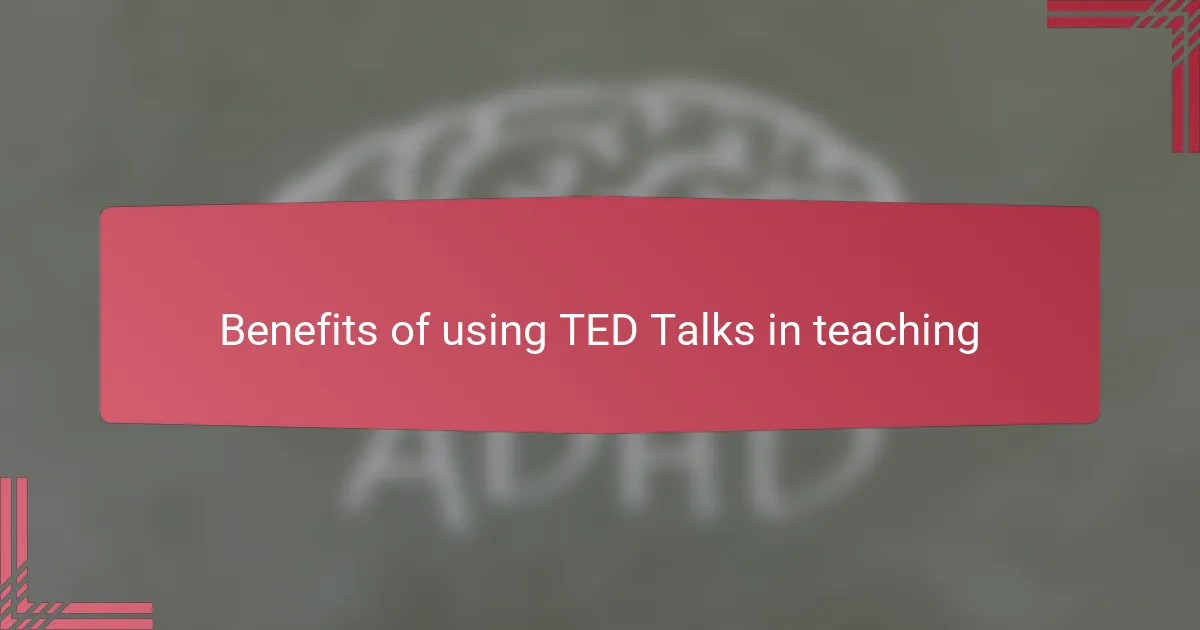
Benefits of using TED Talks in teaching
Using TED Talks in teaching has been a game-changer for me. Their bite-sized yet powerful narratives grab students’ attention instantly, making complex issues feel accessible and relatable. I’ve noticed how students lean in, not just to listen, but to genuinely connect with the speakers’ passion and ideas.
What’s fascinating is how TED Talks spark curiosity and critical thinking simultaneously. I often see my students pause, reflect, and then jump into discussions with renewed energy. Have you witnessed a classroom lighting up just because a story hit home? That’s the kind of engagement TED Talks consistently bring.
Another benefit I appreciate is the diversity of perspectives TED Talks offer. They open windows into experiences and worldviews many students might never encounter otherwise. When you incorporate these voices, learning becomes richer—more empathetic and inclusive—and that, to me, is the heart of activist teaching.
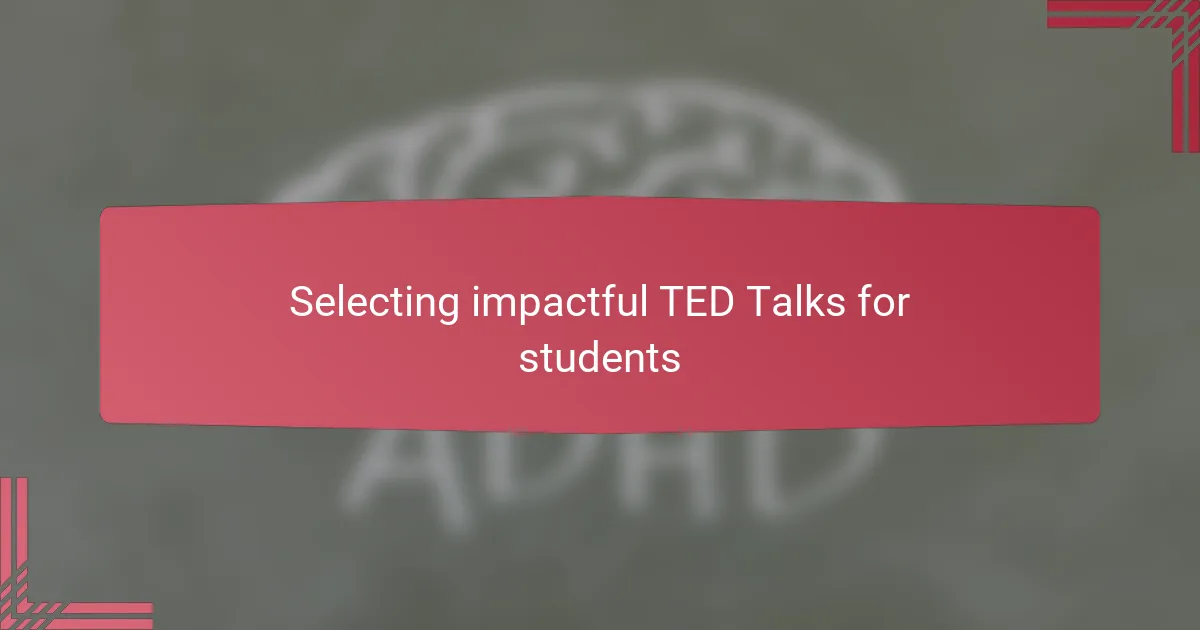
Selecting impactful TED Talks for students
Choosing TED Talks that really resonate with students takes more than just picking popular videos. I always look for talks that spark that moment of recognition—where a student thinks, “Hey, this relates to me or my community.” Don’t you find those talks create a deeper connection that sticks long after the classroom lights go out?
I remember showing a TED Talk on environmental justice that completely changed how one student viewed her own neighborhood. It wasn’t just the facts or figures—it was the personal story woven throughout that made everything feel urgent and real. That’s why I focus on talks with authentic voices and clear calls to action; they move hearts as much as minds.
Selecting impactful TED Talks also means balancing topics students care about with challenges that push their thinking. I sometimes ask myself: will this talk inspire hope, raise critical questions, or invite them to see the world differently? If the answer is yes, then it’s usually a winner in my book.
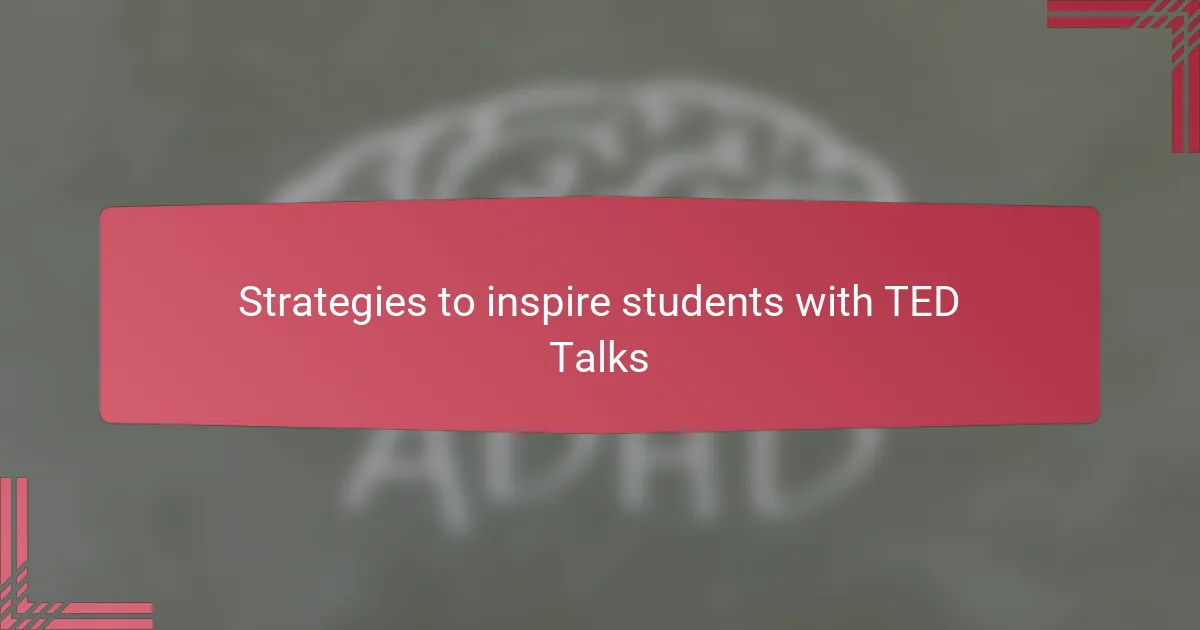
Strategies to inspire students with TED Talks
One strategy I’ve found effective is integrating TED Talks as conversation starters rather than just passive viewing experiences. When I pause a talk and invite students to reflect or debate, their engagement transforms—they begin to see the talk as a springboard for their own ideas and values. Have you ever noticed how a well-timed question can shift a classroom’s energy from silence to spirited exchange? That’s exactly what happens when TED Talks become interactive tools.
Another approach that works well is connecting the themes of TED Talks directly to students’ lives and communities. I recall a moment when a talk about social entrepreneurship sparked a student’s interest not just in business, but in how she could create change locally. This made the ideas tangible and actionable, fueling her enthusiasm beyond the classroom walls. How often do we get to witness that kind of personal inspiration?
Lastly, I emphasize setting clear goals before watching a talk—whether it’s to challenge a misconception or to inspire activism. Framing the TED Talk with a purpose helps students focus and reflect deeper. After all, when students know why they’re listening, the talk ceases to be background noise and becomes a catalyst for growth. Isn’t that what real learning should feel like?
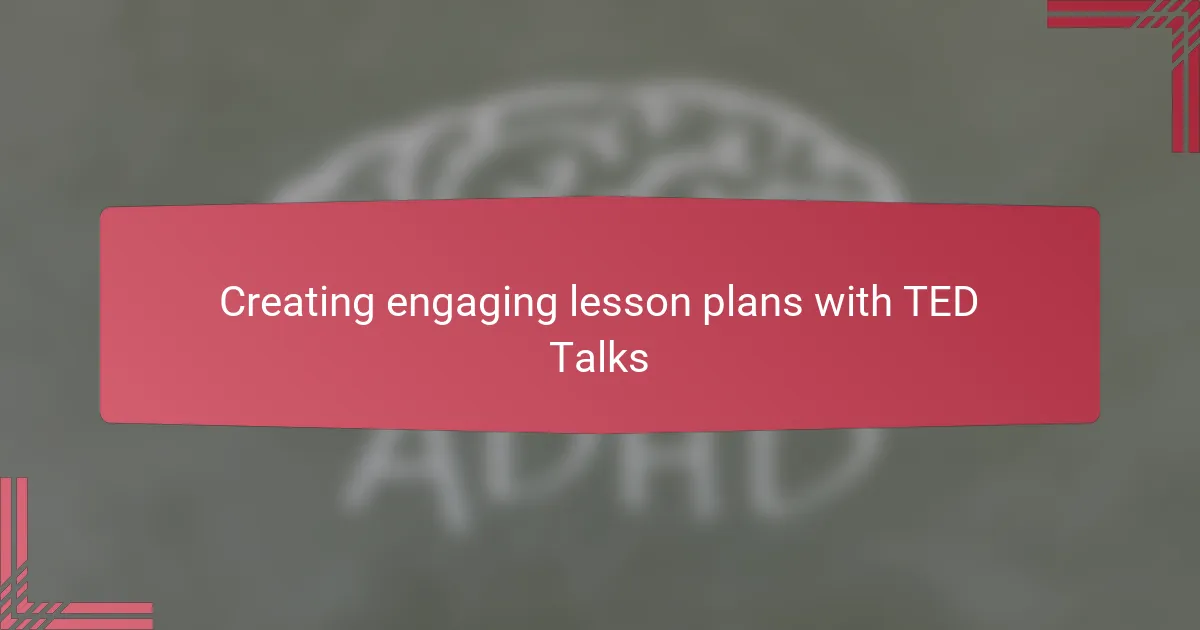
Creating engaging lesson plans with TED Talks
Crafting lesson plans around TED Talks has been one of the most rewarding approaches in my teaching journey. I typically start by identifying the core message I want students to grapple with and then select a talk that brings that theme vividly to life. Have you ever noticed how a well-chosen TED Talk can make abstract ideas suddenly feel tangible and urgent? That’s the kind of connection I aim for when designing each lesson.
I like to structure lessons that don’t just stop at watching but include activities where students respond, debate, or even create their own mini-talks inspired by what they’ve seen. This approach turns passive viewing into active engagement, and from experience, it sparks much deeper curiosity and self-reflection. One time, after a TED Talk about climate activism, my students designed awareness campaigns for our school – that’s when you truly see lesson plans come alive.
Integrating TED Talks also gives me the flexibility to weave in multimedia elements that cater to different learning styles. I often pair a talk with a reflective writing prompt or group discussion, ensuring the lesson resonates on multiple levels. Isn’t it satisfying when students not only understand a topic but also start asking challenging questions themselves? That, to me, is the hallmark of an engaging lesson plan.
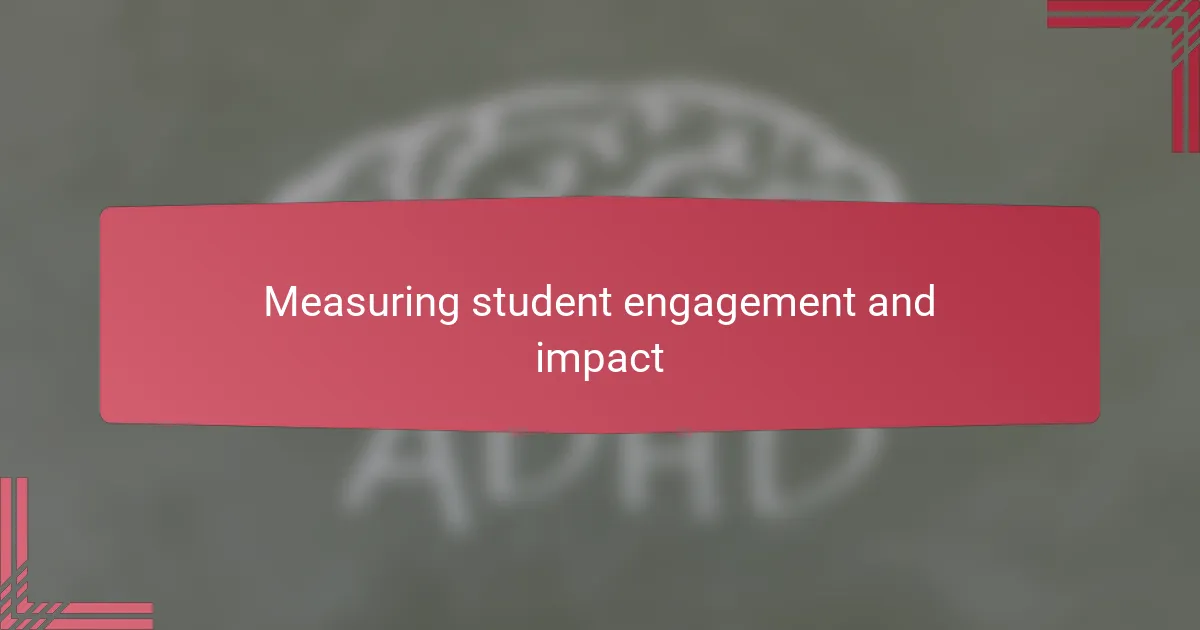
Measuring student engagement and impact
Measuring how deeply students engage with TED Talks isn’t always straightforward, but I’ve found that observing their reactions during discussions offers rich clues. When I see students eagerly asking questions or sharing personal stories triggered by a talk, it tells me the content has truly clicked with them. Don’t those moments of animated conversation feel like the best sign of genuine engagement?
Beyond informal observation, I like to use quick reflective exercises immediately after viewing a TED Talk. I ask students to jot down what stirred them emotionally or what new perspectives they’ve gained. From my experience, these reflections reveal not just comprehension but the seeds of critical thinking taking root—something I value even more than quizzes or tests.
Lastly, tracking how students carry the talk’s themes into their projects or actions has been a key indicator of impact for me. For example, after a TED Talk on social justice, I noticed a group initiating a community campaign weeks later—proof that the lessons weren’t confined to the classroom. Have you ever witnessed a moment when a talk inspired real change? That, to me, is the true measure of success.
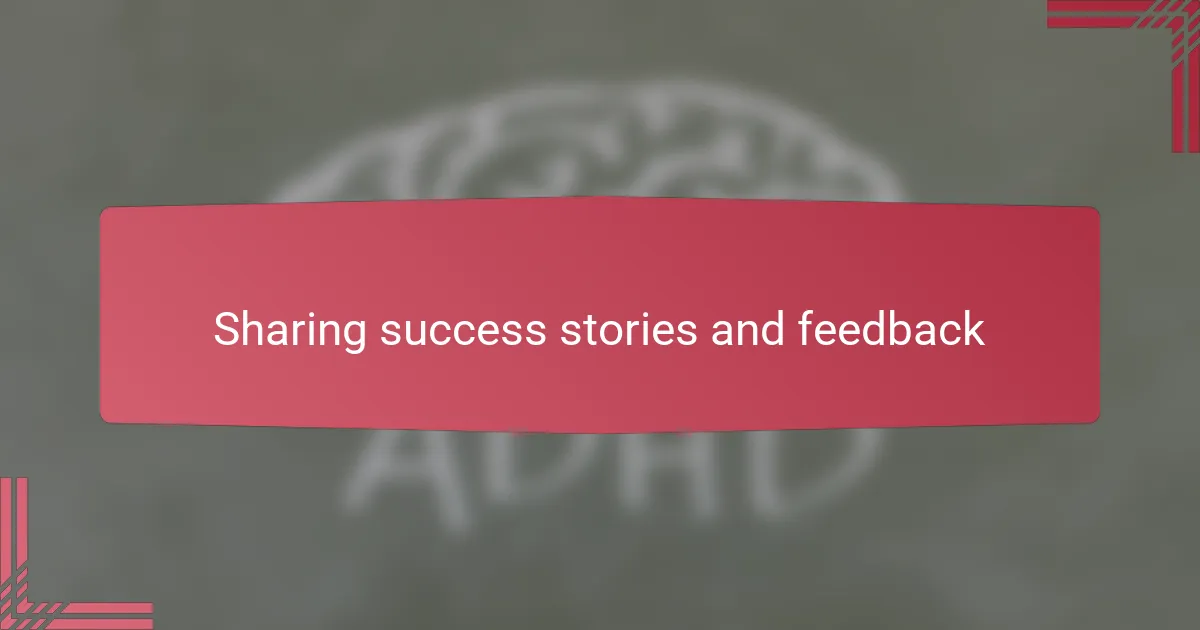
Sharing success stories and feedback
Sharing success stories has always been a powerful motivator in my teaching practice. I remember a student who told me that a TED Talk on mental health gave her the courage to open up about her own struggles. Moments like that remind me why storytelling is so essential—it transforms abstract ideas into real, relatable experiences.
Feedback from students often surprises me in how candid and heartfelt it can be. One unexpected comment I received was how a talk on environmental activism made a typically quiet student feel empowered to speak up in class debates. Isn’t it incredible how a single story can unlock a student’s voice and confidence?
I find that sharing these success stories with colleagues creates a ripple effect of inspiration. When we exchange feedback about what resonated with our students, it helps us refine our approach and discover new TED Talks to try. Have you noticed how collective reflection turns individual wins into a community’s growth?